Corsair said on Friday that its new family of Lux mechanical keyboards for PC gamers is now available across the globe ranging from $120 to $160 in price. There are three units in total, packing 100-percent German-made Cherry MX keyswitches, an aircraft-grade anodized brushed aluminum chassis, and “sophisticated” macro programming. They even sport a cool USB 2.0 pass-through port for extending your desktop’s peripheral arsenal.
Corsair’s new Lux mechanical keyboards are based on the K70, the K70 RGB, and the K65 RGB. They pack on additional premium features like enhanced lighting, special textured key cap sets, and modern font key caps for easier viewing. In fact, they appear to be somewhat identical to the “Rapidfire” variants of those three base models save for the switches, as the Rapidfire models utilize Cherry MX “Speed” switches instead the usual colorful fanfare.

As seen in the chart above, the K70 Lux RGB and K70 Lux keyboards are served up with Cherry MX Red, Cherry MX Brown, or Cherry MX Blue switches, depending on the customer’s preference. As a refresher, “Red” targets PC gamers due to their weight, increasing the time between the user’s physical press of a key and the keyboard’s acknowledgement of the intended command. “Blue” makes an audible click and is mostly aimed at typists while “Brown” doesn’t make any noise and resides somewhere between the other two performance-wise.
Of the three Lux-branded keyboards Corsair introduced on Friday, the K70 Lux RGB appears to be high-end model of the trio. Costing $160, this version includes full RGB illumination, allowing owners to choose a unique backlighting color and intensity for each individual key. Even more, each key can be set with an assigned static color, they can cycle through multiple colors, they can go through a customized palette in waves or ripples, or they can “react” to key presses by changing colors. The overall lighting system is totally insane, and seemingly a must-have for PC gamers wanting lots of glitz on their desktop (cough).
Other highlighted features of the K70 Lux RGB keyboard include onboard memory, large font keycaps, 100-percent anti-ghosting with a 104 key rollover, special textured and contoured keycap sets for FPS and MOGA gamers, a detachable soft-touch wrist rest, and dedicated multimedia controls. The keyboard also supports the company’s CUE Link software for syncing its color scheme with other Corsair peripherals connected to the system.
Meanwhile, the cheaper K70 Lux keyboard seems to be identical, costing $120. However, what you won’t see here is the crazy RGB illumination system. In its place is an overall red or blue lighting emanating under the keys and through the large fonts. Based on the product images, customers can use the CUE Link software to turn on or off individual key lighting, such as illuminating only the WASD keys for right-handed FPS gamers (the lefties use the arrow keys).
Finally, Corsair’s K65 Lux RGB keyboard is a narrower “tenkeyless” version of the K70 Lux RGB model thanks to the removal of the numeric pad. Costing $130, it’s compact and built for “maximum portability,” making it a great addition in the on-the-go PC gamer’s colorful arsenal. And while this model only offers Cherry MX Red switches, it does pack that crazy illumination system for dazzling all of your fans.
PC gamers looking for a colorful new mechanical keyboard can grab one of these Lux models online now through Corsair, or through the company’s authorized retailers and distributors across the globe.



